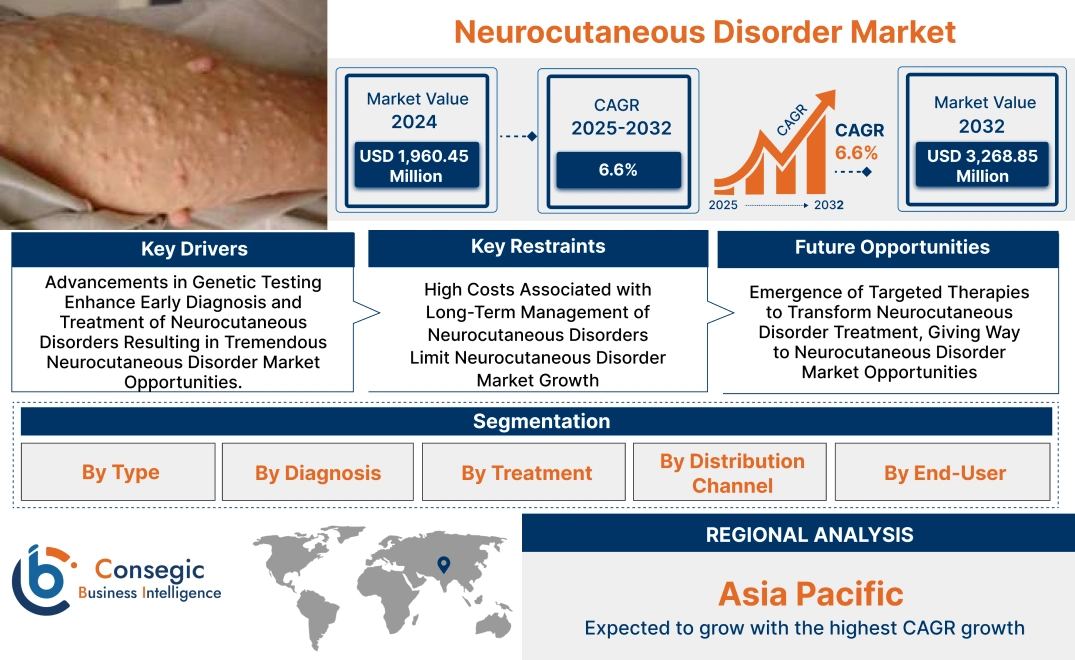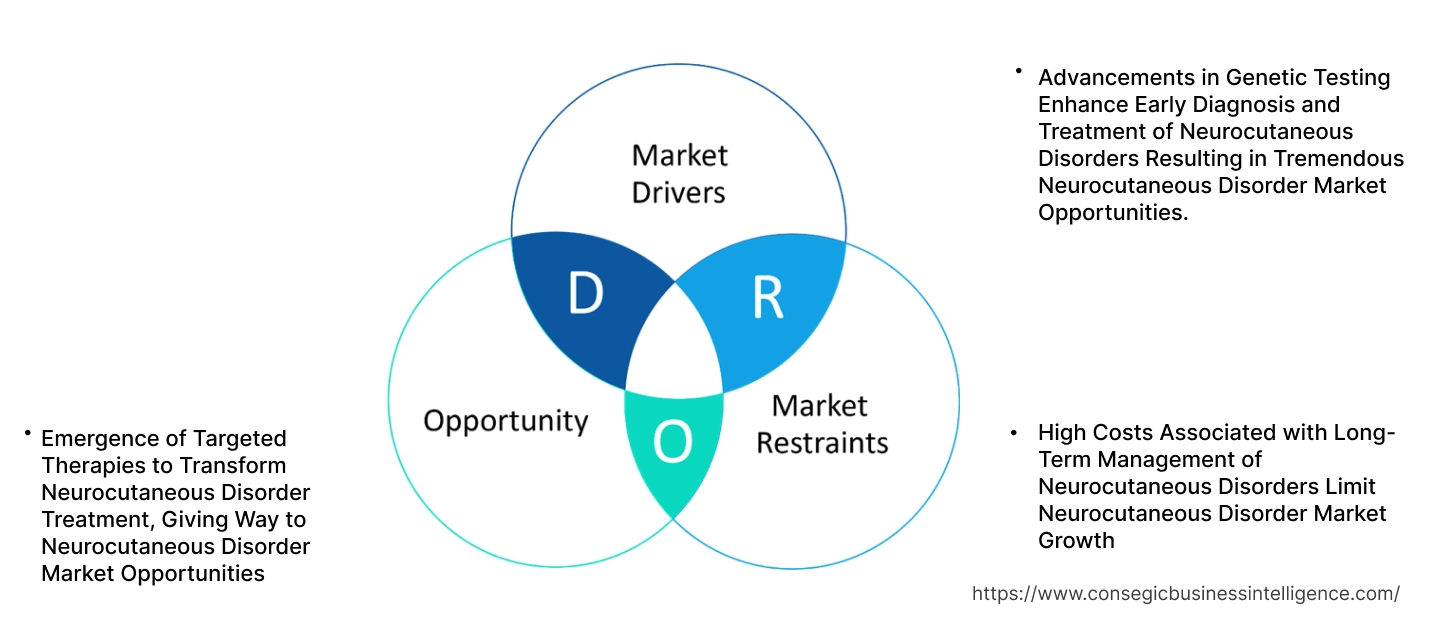Neurocutaneous Disorder Market Size:
Neurocutaneous Disorder Market size is estimated to reach over USD 3,268.85 Million by 2032 from a value of USD 1,960.45 Million in 2024 and is projected to grow by USD 2,054.91 Million in 2025, growing at a CAGR of 6.6 % from 2025 to 2032.
Neurocutaneous Disorder Market Scope & Overview:
Neurocutaneous disorders represent a group of conditions affecting the nervous system and skin, often caused by genetic mutations influencing cellular development. These disorders are typically chronic and require ongoing management and treatment. Products in this market include diagnostic tools, imaging systems, genetic testing solutions, and therapeutic options like pharmacological treatments, surgeries, and rehabilitative services. These products deliver accurate diagnosis, effective symptom control, and personalized care plans tailored to individual patient needs.
Key benefits include improved quality of life, reduced disease progression, and early detection of associated complications. Advanced diagnostic methods enable healthcare providers to implement targeted interventions efficiently. Applications span clinical diagnosis, patient monitoring, and therapeutic interventions. End-use industries include hospitals, specialty clinics, diagnostic laboratories, and research organizations focused on advancing treatments and understanding of neurocutaneous disorders.
Neurocutaneous Disorder Market Dynamics - (DRO) :
Key Drivers:
Advancements in Genetic Testing Enhance Early Diagnosis and Treatment of Neurocutaneous Disorders Resulting in Tremendous Neurocutaneous Disorder Market Opportunities.
Genetic testing plays a crucial role in identifying neurocutaneous disorders such as tuberous sclerosis complex and neurofibromatosis at an early stage. Advanced genetic testing methods enable healthcare providers to detect mutations in genes associated with these conditions, allowing for targeted intervention and management. For instance, next-generation sequencing (NGS) technology has revolutionized diagnostic capabilities by offering comprehensive analysis with high precision. This early detection aids in devising effective treatment plans and improves patient outcomes.
Thus, advancements in genetic testing methods contribute to the increasing demand for diagnostic solutions in the neurocutaneous disorder market.
Key Restraints:
High Costs Associated with Long-Term Management of Neurocutaneous Disorders Limit Neurocutaneous Disorder Market Growth
The management of neurocutaneous disorders often involves significant long-term expenses due to the chronic nature of these conditions. Costs include regular clinical evaluations, imaging studies, genetic testing, and therapies, which can be prohibitive for many patients. For example, treatments like mTOR inhibitors used in tuberous sclerosis can require sustained financial investment, making accessibility challenging for patients without adequate insurance coverage.
These economic barriers restrict the widespread adoption of treatment options, thereby hindering neurocutaneous disorder market growth, particularly in low-income and middle-income countries.
Future Opportunities :
Emergence of Targeted Therapies to Transform Neurocutaneous Disorder Treatment, Giving Way to Neurocutaneous Disorder Market Opportunities
Targeted therapies, including molecular and immunotherapeutic approaches, are poised to revolutionize the treatment of neurocutaneous disorders. Research into mTOR inhibitors and MEK inhibitors is yielding promising results in managing conditions such as tuberous sclerosis and neurofibromatosis. These therapies aim to address the underlying genetic mutations and pathways responsible for disease progression, offering improved efficacy and reduced side effects compared to conventional treatments. For example, clinical trials investigating new inhibitors for NF1-associated tumors are showing significant potential.
The development and approval of such targeted therapies are expected to create substantial opportunities for the neurocutaneous disorder market in the coming years.
Neurocutaneous Disorder Market Segmental Analysis :
By Type:
Based on type, the neurocutaneous disorder market is segmented into neurofibromatosis (Type 1 and Type 2), tuberous sclerosis complex (TSC), Sturge-Weber syndrome, Von Hippel-Lindau disease, ataxia-telangiectasia, and other rare disorders.
The Neurofibromatosis (Type 1 and Type 2) segment accounted for the largest revenue in neurocutaneous disorder market share in 2024.
- Neurofibromatosis is a common neurocutaneous disorder characterized by the growth of benign tumors along nerves and other complications like skin abnormalities and hearing loss.
- Increasing awareness, improvements in early diagnosis, and a rising number of targeted therapies are contributing to the segment's trend.
- High prevalence rates and consistent advancements in drug formulations aimed at managing symptoms are expected to support continued trend.
- The chronic nature of the disorder necessitates long-term management, adding to the demand for continuous care.
- Therefore, according to neurocutaneous disorder market analysis, neurofibromatosis segment leads in revenue due to its high prevalence and chronic impact.
The Tuberous Sclerosis Complex (TSC) segment is expected to register the fastest CAGR during the forecast period.
- TSC is a rare genetic disorder that leads to the development of tumors in multiple organs and is often associated with epilepsy and developmental delays.
- The growing research landscape in TSC is driving innovations in targeted therapies, especially mTOR inhibitors, to control tumor growth.
- As awareness and understanding of the disorder improve, more early-stage diagnoses are occurring, fueling demand for therapeutic interventions.
- The rarity of the disease makes clinical trials for new treatments essential, which further supports neurocutaneous disorder market trend.
- Thus, according to neurocutaneous disorder market analysis, TSC is experiencing the fastest trend due to advancements in genetic research and targeted therapies.
By Diagnosis:
Based on diagnosis, the market is segmented into imaging tests (MRI, CT scan), genetic testing, biopsy, and blood tests.
The Imaging Tests segment accounted for the largest revenue in neurocutaneous disorder market share in 2024.
- Imaging techniques such as MRI and CT scans are essential in identifying structural abnormalities and guiding treatment decisions for patients with neurocutaneous disorders.
- Advances in imaging technologies, such as high-resolution MRIs and 3D imaging, are improving diagnostic accuracy.
- Widespread usage of imaging in both early and routine diagnosis increases its contribution to the market.
- Imaging tests also play a crucial role in monitoring disease progression and assessing the effectiveness of treatments.
- Therefore, according to market analysis, imaging tests currently dominate the diagnostic segment due to their widespread use and technical advancements.
The Genetic Testing segment is anticipated to register the fastest CAGR during the forecast period.
- Genetic tests help identify specific mutations responsible for neurocutaneous disorders, enabling more accurate diagnoses and personalized treatments.
- With technological advancements in genomics, genetic testing is becoming more affordable and accessible, driving wider adoption.
- Early detection through genetic testing enables proactive management and treatment of conditions before they progress.
- The rise in genetic counseling and patient awareness is also increasing the demand for these tests.
- Therefore, according to market analysis, genetic testing is growing rapidly as a result of its ability to enable early detection and precision medicine.
By Treatment:
Based on treatment, the market is segmented into medications, surgery, rehabilitation therapy, and supportive care. The medication segment is further divided into antiepileptic drugs, immunosuppressants, and targeted therapy drugs.
The Medications segment accounted for the largest revenue share in 2024.
- Medications, particularly antiepileptic drugs and targeted therapies, play a pivotal role in managing symptoms of neurocutaneous disorders.
- The development of specific therapies for neurofibromatosis and TSC, such as mTOR inhibitors, is expanding the treatment options available for patients.
- Clinical trials and ongoing drug development in both generic and novel drug categories continue to fuel the segment's expansion.
- The rising adoption of targeted treatments has led to better patient outcomes and reduced disease progression.
- Therefore, according to market analysis, medications remain the leading treatment method, particularly due to the development of targeted therapies,
The rehabilitation therapy segment is anticipated to register the fastest CAGR during the forecast period.
- Rehabilitation plays an essential role in addressing the neurodevelopmental and motor deficits seen in many neurocutaneous disorders.
- With a focus on improving quality of life, rehabilitation services include speech, physical, and occupational therapies, essential for improving patient mobility and cognitive function.
- An increase in the availability of specialized rehabilitation centers and at-home care solutions is contributing to segment trend.
- Technological advancements in virtual rehabilitation tools and telemedicine are enhancing the delivery of services.
- Thus, according to market analysis, rehabilitation therapy is emerging as a critical component of care, particularly for improving functional outcomes.
By Distribution Channel:
Based on distribution channels, the market is segmented into hospital pharmacies, retail pharmacies, and online pharmacies.
The hospital pharmacies segment accounted for the largest revenue share of 47.50% in 2024.
- Hospital pharmacies play a vital role in dispensing prescribed medications, including specialized therapies for neurocutaneous disorders.
- The integration of hospital pharmacies with multidisciplinary care teams ensures that patients receive timely medications and appropriate monitoring.
- The continuous development of new drugs and treatments for neurocutaneous disorders further supports the trend of hospital pharmacies.
- Therefore, according to market analysis, hospital pharmacies lead the market in revenue due to their integration within healthcare institutions.
The online pharmacies segment is anticipated to register the fastest CAGR during the forecast period.
- Online pharmacies provide patients with the convenience of purchasing medications from the comfort of their homes.
- The trend of e-commerce platforms and digital health initiatives, including home delivery services, is enhancing accessibility to medications for neurocutaneous disorders.
- As patients increasingly turn to online pharmacies for convenience and affordability, this segment is becoming an essential part of the distribution network.
- Thus, according to market analysis, online pharmacies are rapidly expanding as a result of the growing demand for convenience and digital healthcare solutions.
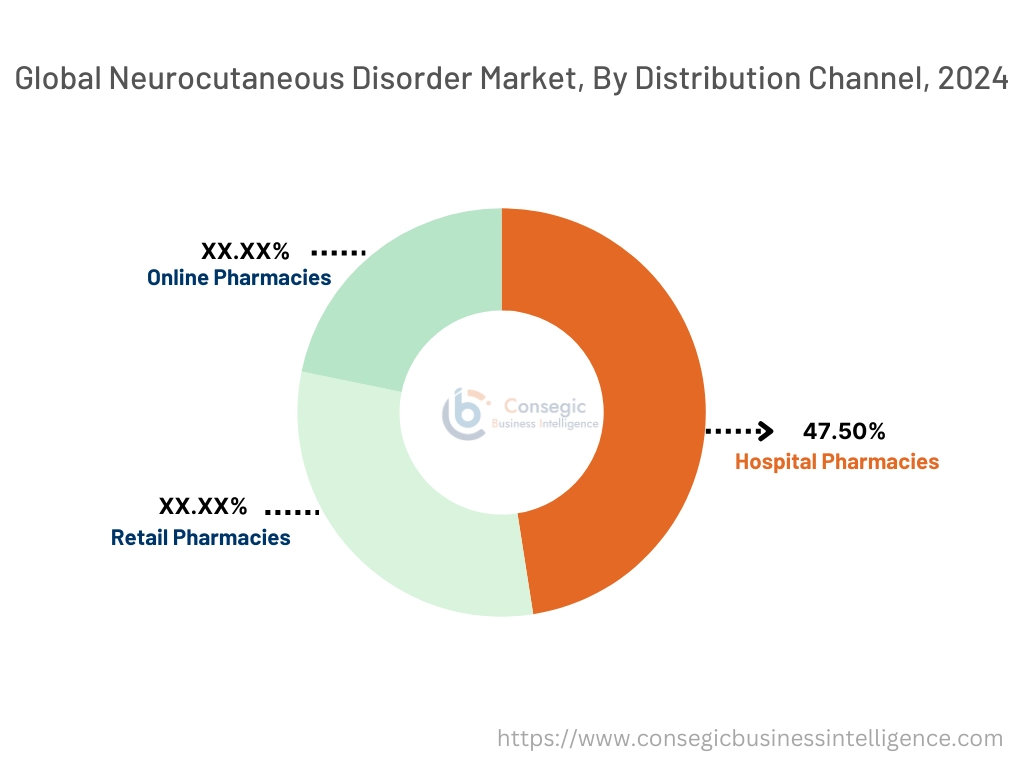
By End-User:
Based on end-users, the market is segmented into hospitals, specialty clinics, ambulatory surgery centers, and research and academic institutions.
The hospitals segment accounted for the largest revenue share in 2024.
- Hospitals offer comprehensive care, including diagnostics, medications, surgical interventions, and rehabilitation services for neurocutaneous disorders.
- Hospitals are equipped with multidisciplinary teams, capable of providing a wide range of treatments that cater to the complex needs of patients with neurocutaneous disorders.
- As healthcare infrastructure expands globally, particularly in emerging economies, hospitals are becoming the key point of care for patients with these conditions.
- The growing number of hospitals with specialized neurocutaneous disorder units further strengthens this segment.
- Therefore, according to market analysis, hospitals continue to dominate the end-user segment due to their comprehensive services and high patient volume.
The Specialty Clinics segment is anticipated to register the fastest CAGR during the forecast period.
- Specialty clinics focus on providing expert care for specific neurocutaneous disorders, ensuring personalized treatment approaches.
- The rise in specialized clinics offering advanced diagnostic services and treatment protocols tailored to rare conditions is driving the trend of this segment.
- Increased collaboration between specialty clinics and research institutions is also contributing to the development of more precise treatments.
- The growing popularity of outpatient care, which allows patients to receive treatments without the need for hospitalization, is boosting the adoption of specialty clinics.
- Thus, according to market analysis, specialty clinics are experiencing the fastest growth due to their focused care and technological advancements.
Regional Analysis:
The regional segment includes North America, Europe, Asia Pacific, Middle East and Africa, and Latin America.
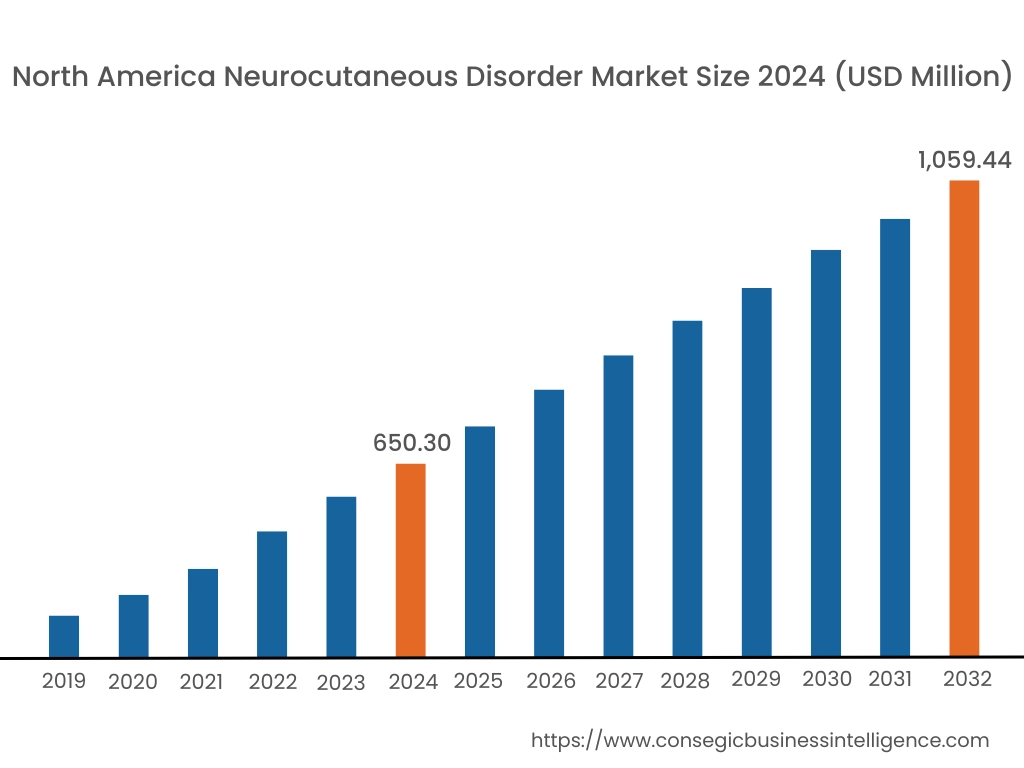
In 2024, North was valued at USD 650.30 Million and is expected to reach USD 1,059.44 Million in 2032. In North America, the U.S. accounted for the highest share of 71.30% during the base year of 2024.
North America holds a significant share of the neurocutaneous disorder market, primarily driven by advanced healthcare infrastructure and high awareness of genetic conditions. The United States is a key contributor, with a high number of diagnosed cases and active research initiatives. Increased funding for research into neurocutaneous disorders, along with the presence of leading pharmaceutical companies and healthcare facilities, supports market growth. Government programs aimed at providing financial assistance for rare diseases further enhance access to treatments and care options.
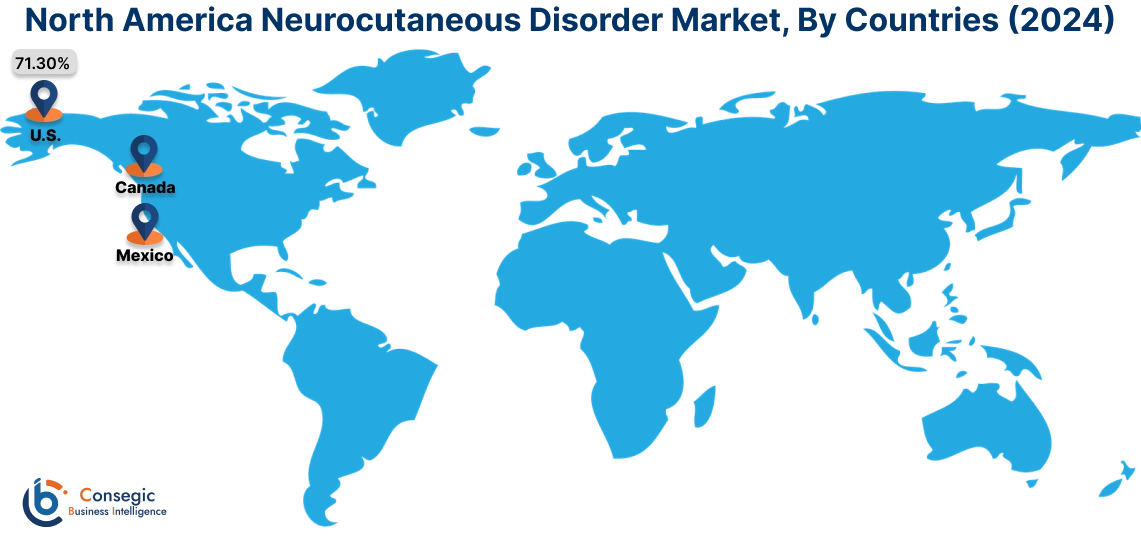
In Asia Pacific, the market is experiencing the fastest growth with a CAGR of 7.0% over the forecast period.
Asia-Pacific is witnessing a steady rise in the neurocutaneous disorder market, influenced by both improving healthcare systems and increasing awareness of rare genetic conditions. Countries like Japan, China, and India are the major contributors to the market. While Japan benefits from advanced medical technologies and widespread awareness, China and India face challenges in terms of diagnostic capabilities and access to specialized care. However, rising healthcare investments and government efforts to increase awareness of rare disorders are expected to foster neurocutaneous disorder market expansion in these regions.
Europe represents a mature market for neurocutaneous disorders, with countries such as Germany, France, the UK, and Italy showing robust demand for both diagnostics and treatments. The European Union’s healthcare policies, focusing on rare diseases, have facilitated greater access to specialized care and therapies. The market benefits from a well-established healthcare infrastructure, high levels of research in genetic disorders, and government initiatives to fund treatments. However, the market's growth in Eastern Europe remains constrained by economic factors and limited access to advanced healthcare services.
The Middle East and Africa region faces varied market conditions. The Middle East, particularly countries like the UAE and Saudi Arabia, has seen increased awareness of neurocutaneous disorders, along with improvements in healthcare infrastructure. However, challenges remain in Africa, where limited access to healthcare services, lack of awareness, and diagnostic limitations hinder market development. Nonetheless, international collaborations and growing focus on rare diseases in the region are likely to drive market progress. The increasing adoption of genetic research and diagnostic technologies could positively influence the market in the coming years.
Latin America’s neurocutaneous disorder market is characterized by moderate growth, with Brazil and Mexico being the largest markets in the region. While there is growing awareness about neurocutaneous disorders, challenges persist in terms of access to advanced diagnostic tools and treatment options. Socioeconomic factors and disparities in healthcare infrastructure between urban and rural areas can hinder the market's potential in some countries. However, government health initiatives and international collaborations to improve healthcare access are expected to support steady market progress.
Top Key Players and Market Share Insights:
The Global Neurocutaneous Disorder Market is highly competitive with major players providing products and services to the national and international markets. Key players are adopting several strategies in research and development (R&D), product innovation, and end-user launches to hold a strong position in the Global Neurocutaneous Disorder Market. Key players in the Neurocutaneous Disorder industry include-
- Novartis International AG (Switzerland)
- Pfizer Inc. (United States)
- Teva Pharmaceutical Industries Ltd. (Israel)
- Johnson & Johnson (United States)
- Horizon Therapeutics (Ireland)
- Sanofi S.A. (France)
- Eli Lilly and Co. (United States)
- Bristol-Myers Squibb (United States)
- Merck & Co., Inc. (United States)
- AstraZeneca PLC (United Kingdom)
Neurocutaneous Disorder Market Report Insights :
| Report Attributes | Report Details |
| Study Timeline | 2019-2032 |
| Market Size in 2032 | USD 3,268.85 Million |
| CAGR (2025-2032) | 6.6% |
| By Type |
|
| By Diagnosis |
|
| By Treatment |
|
| By Distribution Channel |
|
| By End-User |
|
| By Region |
|
| Key Players |
|
| North America | U.S. Canada Mexico |
| Europe | U.K. Germany France Spain Italy Russia Benelux Rest of Europe |
| APAC | China South Korea Japan India Australia ASEAN Rest of Asia-Pacific |
| Middle East and Africa | GCC Turkey South Africa Rest of MEA |
| LATAM | Brazil Argentina Chile Rest of LATAM |
| Report Coverage |
|
Key Questions Answered in the Report
How big is the Neurocutaneous Disorder Market? +
In 2024, the Neurocutaneous Disorder Market was USD 1,960.45 million.
What will be the potential market valuation for the Neurocutaneous Disorder Market by 2032? +
In 2032, the market size of Neurocutaneous Disorder Market is expected to reach USD 3,268.85 million.
What are the segments covered in the Neurocutaneous Disorder Market report? +
The diagnosis and end-user industry are the segments covered in this report.
Who are the major players in the Neurocutaneous Disorder Market? +
Novartis International AG (Switzerland), Pfizer Inc. (United States), Sanofi S.A. (France), Eli Lilly and Co. (United States), Bristol-Myers Squibb (United States), Merck & Co., Inc. (United States), AstraZeneca PLC (United Kingdom), Teva Pharmaceutical Industries Ltd. (Israel), Johnson & Johnson (United States), Horizon Therapeutics (Ireland) are the major players in the Neurocutaneous Disorder market.
